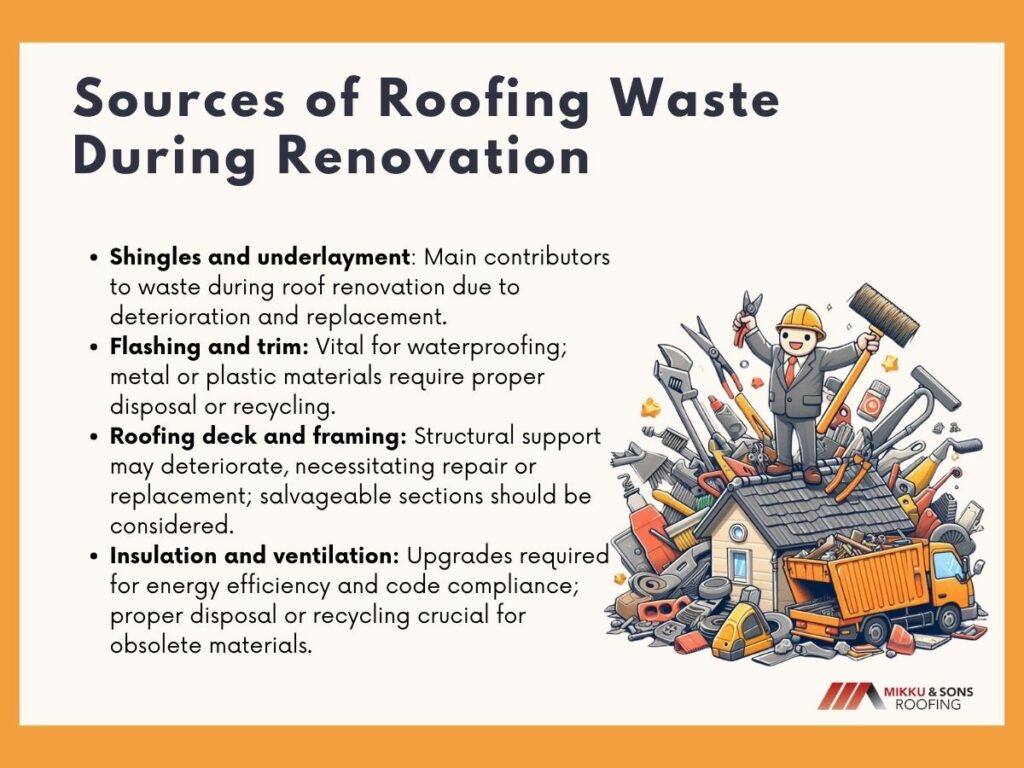

Renovating a roof is significant for any homeowner or property owner, often necessitated by age, wear and tear, or the desire for aesthetic or functional upgrades. However, what many might not realize is that roof renovation typically generates considerably more waste compared to installing a brand-new roof.
This extra waste results from disassembling preexisting materials, replacing damaged parts, and measuring and planning errors associated with remodeling projects. Reducing roofing waste during renovations has become crucial to sustainable construction methods as environmental concerns gain momentum.
Determining the origins of roofing waste is essential to developing measures limiting its environmental impact and lowering rehabilitation projects' ecological footprint.
It's important to understand the many sources contributing to the waste stream when restoring a roof. This allows homeowners and contractors to create focused waste reduction programs and optimize resources.
Every component involved in a renovation, from the outermost layer of shingles to the structural elements supporting the roof, contributes to waste production.

Shingles and underlayment form the primary defense against weather elements such as rain, snow, and UV radiation. Over time, these materials can deteriorate, leading to leaks, damage, or aesthetic concerns that prompt renovation.
During the removal process, old shingles and underlayment are typically torn off and discarded, contributing significantly to the waste generated.
Flashing and trim are essential components of a roof's waterproofing system, preventing water infiltration at vulnerable points such as roof edges, valleys, and intersections. While durable, flashing and trim may require replacement during renovation due to damage, corrosion, or aesthetic considerations.
As these components are often made of metal or plastic materials, proper disposal or recycling is essential to reduce the environmental impact of their disposal.
Beneath the visible layers of shingles and underlayment lies the roofing deck and framing structure, providing structural support and stability to the roof. Over time, these components may deteriorate due to moisture damage, rot, or pest infestation, necessitating repair or replacement during renovation.
However, not all roofing deck and framing materials need to be discarded entirely, as some sections may still be salvageable or suitable for restoration.
In addition to providing thermal insulation and moisture control, insulation and ventilation components play a crucial role in maintaining indoor comfort and energy efficiency. During roof renovation, insulation materials such as fiberglass batts or spray foam may need to be replaced or upgraded to meet current building codes and energy standards.
Similarly, ventilation components such as ridge vents or soffit vents may require inspection, repair, or replacement to ensure proper airflow and moisture management. It's critical to properly dispose of or recycle obsolete ventilation components and insulation during renovations to reduce waste and environmental damage.
It's important to understand that not every component of an old roof needs to be replaced before starting a renovation project. Reusing, refurbishing, or repurposing a large number of roof structure components will cut down on waste and lessen the renovation's negative environmental effects.
Reusable component evaluation and identification can help builders and homeowners embrace sustainable techniques that encourage conservation and resource efficiency.

Materials used for roof cladding, such as metal panels, asphalt shingles, and tiles, present a multitude of opportunities for imaginative repurposing beyond their initial function. Homeowners can use their creativity to turn these materials into distinctive, useful, and aesthetically beautiful elements for both indoor and outdoor areas.
Garden Pathways: Break old asphalt shingles into smaller pieces and use them as durable, weather-resistant materials for creating garden pathways or walkways. Their rough texture provides excellent traction, and their dark color can complement various landscaping themes.
Siding for Outdoor Structures: Repurpose intact asphalt shingles as cost-effective siding for outdoor sheds, playhouses, or chicken coops. Their lightweight nature and ease of installation make them an ideal choice for DIY projects, offering both durability and weather resistance.
Decorative Accents: Get creative with old asphalt shingles by using them as decorative accents in outdoor landscaping. Arrange broken shingles to create mosaic patterns in garden walls or stepping stones, adding a pop of color and texture to your outdoor spaces.
Wall Art: Cut and shape old metal roofing panels into unique wall art pieces for interior spaces. Whether you opt for abstract designs or intricate patterns, metal panels can add a touch of industrial-chic elegance to living rooms, bedrooms, or home offices.
Statement Pieces: Accept metal panels' adaptability by transforming them into eye-catching furniture. To combine practicality with a unique aesthetic, consider utilizing salvaged metal panels to create coffee tables, end tables, or shelving units.
Outdoor Décor: Take your outdoor décor to the next level with repurposed metal panels. Create striking privacy screens for patios or balconies, design custom trellises for climbing plants, or fashion eye-catching sculptures for garden landscapes, adding a touch of modern sophistication to your outdoor oasis.
Mosaic Accents: Use broken or mismatched roofing tiles to create vibrant mosaic accents for outdoor spaces. Arrange tiles in intricate patterns to adorn garden walls, fountain surrounds, or outdoor kitchen countertops, infusing your landscape with artistic flair.
Stepping Stones: Transform intact roofing tiles into charming stepping stones for garden pathways or stepping stone mosaic designs. Arrange tiles in various shapes and sizes, embedding them in concrete or gravel paths to create functional yet visually appealing walkways.
Tabletops and Countertops: Repurpose sturdy roofing tiles as tabletops or countertops for outdoor furniture or kitchen islands. Seal the tiles with weather-resistant coatings to protect against the elements, creating durable surfaces that withstand outdoor use while adding rustic charm to your outdoor entertaining spaces.
Trim and flashing components, typically made from materials like metal or plastic, are essential for waterproofing and finishing the edges, corners, and transitions of a roof. Rather than disposing of these components during a renovation, consider repurposing them into creative and practical features for both indoor and outdoor spaces.
Here are some inventive ways to transform trim and flashing:
Custom Signage: Use old metal flashing to craft custom signage for your home or garden. Cut the flashing into desired shapes and sizes, then paint or engrave letters and designs to create personalized address plaques, garden markers, or directional signs.
Artistic Décor: Turn metal flashing into striking pieces of wall art or sculpture for interior or exterior spaces. Bend, fold, or cut the flashing into geometric shapes or abstract forms, then mount them on walls or display them as freestanding sculptures to add modern sophistication to your décor.
Functional Furniture: Repurpose metal flashing into functional furniture pieces such as shelves, benches, or tables. Weld or fasten multiple pieces of flashing together to create sturdy frameworks, then add wooden or glass tops to transform them into stylish and durable furniture accents.
Vertical Gardens: Convert plastic trim components into vertical garden planters for indoor or outdoor use. Cut the trim into sections and attach them to walls or fences, then fill the compartments with soil and plant herbs, succulents, or small flowers to create living green walls that add beauty and freshness to your space.
Decorative Panels: Use plastic trim pieces to construct decorative panels or screens for privacy, shade, or aesthetic enhancement. Arrange the trim in geometric patterns or lattice designs, then attach them to existing structures such as pergolas, fences, or balcony railings to create visually appealing focal points in your outdoor living areas.
Playful Planters: Transform plastic trim components into playful planters for whimsical garden accents. Cut the trim into various shapes and sizes, then assemble them into creative arrangements such as animal shapes, abstract sculptures, or architectural landmarks.
Fill the planters with soil and colorful flowers or foliage to bring joy and character to your garden landscape.
Gutters and downspouts are integral components of a roofing system, directing rainwater away from the roof and foundation of the home to prevent water damage and erosion. Rather than discarding these components during a renovation, explore creative ways to repurpose them for functional and decorative purposes.
Here are several innovative ideas for reusing gutters and downspouts:
Repurpose old gutters as raised garden beds for growing herbs, vegetables, or flowers. Mount the gutters horizontally along fences, walls, or railings, then fill them with potting soil and plant your favorite crops or ornamental plants.
Gutter garden beds are ideal for small spaces, balconies, or areas with limited ground space.
Cut sections of gutters to create DIY planters for vertical gardening. Hang the gutter segments horizontally or vertically on walls, fences, or trellises, then fill them with soil and plant cascading flowers, succulents, or trailing vines.
Arrange multiple gutter planters to create living green walls or vibrant botanical displays.
Utilize gutters as practical organizers for storing and organizing gardening tools, hand tools, or craft supplies. Mount the gutters vertically on walls in garages, sheds, or workshops, then place tools, brushes, or other items within easy reach.
Gutter organizers help maximize storage space and keep essentials neatly organized.
Construct sturdy stands for rain barrels using repurposed gutters and downspouts. Cut sections of gutter to match the length and width of the rain barrel base, then assemble them into a rectangular frame.
Place the rain barrel on top of the gutter stand to elevate it for easy access and efficient rainwater collection.
Repurpose downspouts as vertical storage solutions for organizing umbrellas, walking sticks, or garden stakes. Mount downspouts vertically on walls or fences near entryways or outdoor living areas, then slide items into the openings for convenient access and clutter-free storage.
Roofing accessories, such as vents, skylights, and chimney caps, play vital roles in the functionality and aesthetics of a roof. Rather than discarding these components during a renovation, explore innovative ways to repurpose them for both practical and decorative purposes.
Here are several creative ideas for reusing roofing accessories:
Transform old roof vents into charming planters for indoor or outdoor use. Clean the vents thoroughly and fill them with potting soil, then plant herbs, succulents, or flowering plants to create unique botanical displays.
Hang the vent planters on walls, fences, or trellises to add greenery and character to your space.
Convert unused chimney caps into cozy birdhouses for feathered friends. Clean and paint the chimney caps with non-toxic, weather-resistant paint, then install them on poles or tree branches to provide nesting sites for birds.
Add perches, nesting boxes, and feeder trays to attract a variety of bird species to your backyard.
Use decorative patterns or stencils to transform plain roof vents into eye-catching design elements. Paint the vents with weather-resistant paints in bold colors or intricate patterns, then install them as decorative accents on exterior walls, fences, or garden sheds.
The decorative vent covers add visual interest and architectural flair to your outdoor spaces.
Repurpose old skylights into miniature greenhouses for starting seeds or growing small plants. Seal the edges of the skylights with weatherproof caulking or silicone, then place them on sturdy frames or tables in sunny locations.
Use the skylight greenhouses to extend the growing season or protect delicate plants from harsh weather conditions.
Turn old chimney caps into charming wind chimes for outdoor relaxation. Attach small bells, chimes, or decorative ornaments to the chimney caps using sturdy wires or strings, then hang them from tree branches, pergolas, or porch ceilings.
The chimney cap wind chimes create soothing sounds and add whimsical charm to your outdoor living spaces.
There are many chances for homeowners and contractors to embrace sustainability and creativity during the roof renovation process. Rethinking and repurposing roofing components and materials can help you reduce waste, save resources, and give your house and yard a distinctive look.
Knowing when to replace your roof is crucial to protecting your investment and maintaining the structural integrity of your house. Its lifespan can be increased with routine upkeep and repairs, but eventually, replacement is required.
How can you determine if your roof needs to be replaced? Continue reading to find out when you may put these waste-reduction techniques into practice. Think creatively and consider repurposing when you start your next roofing renovation project; often, the greatest ideas come from the stuff we already own.
